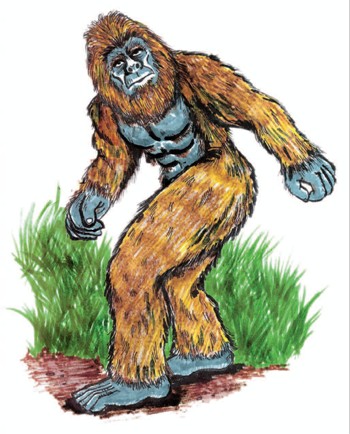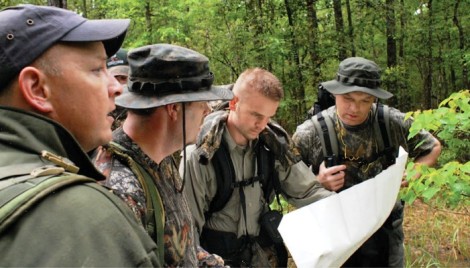UNIVERSITY PRESS
The Newspaper of Lamar University and Lamar Institute of Technology
Friday, December 5, 2008; Vol. 85 No. 18
TBRC sets out to document ‘rare, but very real species’—Bigfoot
From the Yeti of the Himalayas to the Sasquatch of North America, legends of a large, hairy, bi-pedal primate have been told the world over for centuries.
The Texas Bigfoot Research Conservancy seeks to prove the existence of the legendary creature and separate fact from myth.
The TBRC began in 1999 as a cyber network for people to share information and experiences about the creatures.
Lorena, Texas, resident and spokesman for the TBRC Daryl Colyer said the group was co-founded by Craig Woolheater of Mansfield after having a visual encounter with something he could not explain.
“All he knew was that he had an encounter with what fit the description of what people call the Bigfoot,” Colyer said. “It was he and his wife that had the encounter—at that time she was his girlfriend. They were driving down a highway in Louisiana near Alexandria—it was about 11 or 12 at night and they saw this large, hairy thing about 7 feet tall or so. As they put it, it had grey hair, from top to bottom. It was walking parallel to the highway in the same direction they were going. According to Craig, they had a good visual on it for five to six seconds — from the time they first saw it with their high beams on it until they actually passed it. It was about 15 feet or so off of the road. So they got a pretty good look at it.
encounter—at that time she was his girlfriend. They were driving down a highway in Louisiana near Alexandria—it was about 11 or 12 at night and they saw this large, hairy thing about 7 feet tall or so. As they put it, it had grey hair, from top to bottom. It was walking parallel to the highway in the same direction they were going. According to Craig, they had a good visual on it for five to six seconds — from the time they first saw it with their high beams on it until they actually passed it. It was about 15 feet or so off of the road. So they got a pretty good look at it.
“That changed Craig’s life and he began to seek out others with similar experiences. That led to him founding the TBRC, at that time called the Texas Bigfoot Research Center….From there it evolved into a team of amateur investigators including people from all professions. We have taken it much farther than that now. We are now a non-profit organization. We have a number of biologists in the organization.”
Colyer said the main objective of the TBRC is to verify and document the species so it can be officially recognized by governmental entities as well as mainstream science. “The main goal of the organization is to document what we believe is a very rare, but very real species of primate,” he said. “Based on credible eye-witness accounts — of which we have close to 300 in our database, our own accounts — which include visual encounters and trace evidence — tracks, hair, also based on ecological patterns that you can discern from analyzing those reports, we believe there is a real species out there.”
Colyer describes the creature as something like a large, upright great ape. “That’s what we think this thing is. Most of the data seems to indicate this is a rare, undocumented, bi-pedal great ape. A lot of the behavior that has been attributed to Sasquatch has been documented as being great ape behavior such as threat and intimidation displays, carrying off hogs,” he said.“ For the longest time hunters would report seeing a Bigfoot carry off a wild hog. A farmer once reported a Bigfoot stealing a 200-pound pig from its pen.
“If a 4-foot chimpanzee can carry off a 40- or 50-pound hog, surely a 7-foot, unknown great ape can carry off a 200-pound pig?
“There have been reports of Sasquatch fishing and using sticks to spear fish and we have documented reports of orangutans stick fishing. We underestimate how intelligent the great apes are.”
Colyer said Sasquatch is likely a descendant of the ancient, giant primate Gigantopithecus.
“There is a precedent for a large [possibly] bi-pedal great ape in the fossil record at least the size of what people call the sasquatch, Gigantopithecus, that existed up to about 200,000 years ago,” he said.
“Fossils have been found in Asia. Some people say that no fossils of it have been found in North America and that is true. But we have found fossils of animals that were contemporary with Gigantopithicus, like the red panda, thought only to have been in Asia. But now we have fossils of it in North America, too. If it was possible for the red panda to cross over to North America then it was probably possible for other species like Gigantopithecus. When you take all the data into account then the idea suddenly becomes a lot more plausible.
“Obviously, if it’s a real species that has remained at large and undocumented all this time, it has to be extremely intelligent — at least as intelligent as orangutans and chimps,” he said. “We think it’s nocturnal which is going to make it even more difficult to track, and we think it’s rare—which will make it even more difficult. So you have got your work cut out for you if you want to find one.
“I would say they are about as smart as orangutans, stealthy as cougars, rare as jaguarundis and have the brawn of a gorilla. I’m not ascribing supernatural qualities to it. I’m just saying that if it’s a real animal it’s pretty unique. If it’s that large and has remained at large this whole time then it has got to be pretty sharp.”
Colyer said the environmental conditions in East Texas share a common thread with other areas that receive numerous Bigfoot sightings.
“There are two areas that we are really focused on right now,” he said, “Southeast Texas, Southeastern Oklahoma and Southwestern Arkansas—the Washita Mountains, which extends from Arkansas and into Oklahoma, and we are also focused on what we call the ‘Primitive Big Thicket’ which includes Big Thicket National preserve and Sam Houston National Forest up to the Davy Crockett National Forest area. Those are the most prolific areas in terms of reported encounters.
“Both areas receive the highest amount of rainfall for each state. Southwestern Arkansas and Southeast Oklahoma receive between 60 and 70 inches of rain a year, they are extremely forested, rugged, remote, low human population density — and the same thing can be said about the Southeast Texas region. The Big Thicket gets anywhere from 60 to 65 inches of rain a year and there are pockets in there that are extremely remote and densely forested and very difficult for humans on foot.
Those seem to be the common threads — where there are few people, lots of woods and lots of water. Again, that’s an ecological pattern that would seem to indicate a living species that has no desire to have contact with people—much like gorillas, they go to the most remote areas, and they do that because they want to be left alone.”
Colyer said the TBRC relies on several methods when collecting data and evidence.
“Our main methodology begins with getting eyewitness reports, and we have a system whereby we evaluate those reports,” he said. “We determine whether we believe they are credible; and if we do, then we go on site and look for trace evidence. We don’t find it very often but we do on occasion.
“If there are enough reports and evidence from an area we go in and deploy camera traps for an extended period of time. That’s really our main focus is trying to get footage or photos. And that may not be enough to get the species listed, but we think if we can get some good, clear and compelling evidence that will lead to more interest, increased efforts and funding so that people can remain in the field for an extended period of time to research this thing.

“There will still be a large group of skeptics who will demand nothing less than a body or specimen. And that’s fine. But we are hoping we can get people to take this more seriously if we can get good, clear photos that can be shown not to be manipulated. Maybe we can prompt a very serious investigation by mainstream science.”
Colyer said the group uses specialized equipment while in the field to aid in their search for evidence.
“We are in extremely remote places, so GPS is our friend,” he said. “We go out in the evening and night sometimes and we may use night vision. But I don’t know that any photos taken using thermal cameras and night vision cameras will be convincing enough to anyone at all. It might demonstrate to us that there’s one there. Then we can focus on more with the camera traps. But we do use night vision when we are out at night. We use thermal units that detect heat signatures off wildlife and you can see on the screen if there is an animal there.”
Colyer said the TBRC remains objective and fairly skeptical in the field, verifying every lead and bit of evidence before accepting it as truth.
“When we are out in the field we don’t accept everything that comes down the pipe,” he said. “For every one report that we think may be legitimate, we get 10 that we dismiss. We have about 300 reports in our database that we believe to be legitimate, and close to 4,000 total reports that the public will never see because we have determined them to be a hoax, fabrication, misidentification and those sorts of things.”
Colyer said the feeling of finding evidence or having an encounter while out in the field is unparalleled.
“The most exciting thing is when you are out there and things happen that you just can’t explain,” he said,”—big rocks being thrown at you and wood knocking sounds in the middle of the Washita National Forest and miles from civilization. We may play aggravated chimpanzee sounds throughout the day and then get a response from the thing by it knocking on a tree with a piece of wood. Yeah — you don’t see it, but no known North American animal does that besides humans and the hypothetical sasquatch.”
Colyer said he wants people to understand these creatures and dispel the view of them being science-fiction.
“The main thing is getting people over that it’s freaky looking,” he said. “It’s so much like us—it walks on two legs, but it’s big and hairy. It fits these childhood images of monsters, so people call it a monster — which of course, monsters don’t exist. Then when you tell people you are a Bigfoot hunter they say, ‘Well, are there more than one?’— well, duh?!”
“We aren’t looking for the tooth fairy or Santa Claus here. We are looking for what we believe is a real species of wildlife. And, of course, there has to be more than one for it to exist. They have to procreate. That’s our biggest hurdle is getting people over the fact that it’s not a monster.” Colyer said his involvement with the TBRC stems from his own encounter with a creature near the Trinity River on State Highway 105 some time ago.
“…The thing is—I have seen one, so I don’t care what people think. I have seen it, and I know it’s out there….Once you have seen something like that it changes a lot of things because suddenly another door opens. Something that you truly thought was myth or legend —once you’ve seen it—the whole game changes.”
Yes. The whole game has changed.
For more information go to texasbigfoot.org.
